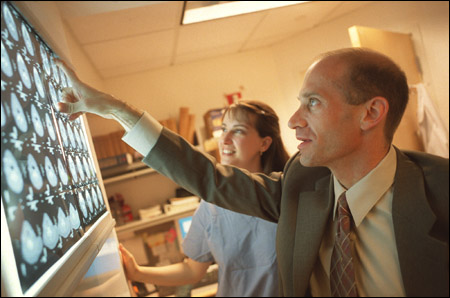PSA rise signals high death risk
It marks prostate cancer progression

P S A are frightening letters for those diagnosed with prostate cancer, some 230,000 men every year. They stand for prostate-specific antigen, a protein the body secretes in excess when a man has the malignancy. It is used as a marker to both diagnose the disease and to detect its recurrence after surgery or radiation. Now, its rate of rise is seen as a marker of prostate-specific death.
New research shows that an increase of PSA in the year before prostate cancer is treated apparently raises the risk of dying about 10-fold in men who had their tumors removed by surgery. Previously, physician-researchers found that a doubling of PSA after treatment with radiation is almost a sure predictor of death from the cancer, which kills about 30,000 men a year.
“Patients whose PSA increased by more than 2 nanograms per milliliter per year during the year before they were treated had a high risk of dying from the disease despite surgery,” says Anthony D’Amico, a professor at the Harvard Medical School (HMS) and a physician at two of its affiliated hospitals in Boston, Brigham and Women’s Hospital and Dana Farber Cancer Institute. He and his collaborators at three other medical schools followed 1,095 men whose cancer was detected by their PSA levels and who then underwent surgery
Some men with PSA levels of 4 or higher choose a category known as “watchful waiting,” wherein both the patient and his doctors agree that the potential side effects of treatment, including incontinence and impotence, exceed the expected benefits. In some cases, particularly in older men, the cancer grows so slowly patients die from heart disease, diabetes, or other causes rather than from the cancer.
Results from the team’s study indicate that watchful waiting is not a good option if their PSA level increases at the rate of 2 per year. Details of the research appear in the July 8 issue of the New England Journal of Medicine.
Waiting may not be a good idea even if a guy’s PSA is not rising that fast. “Even in the case of men considered at a low risk of needing treatment,” D’Amico notes, “most of the time we find significant cancer” when they undergo surgery or radiation. “Only 8 percent may have something small enough to be watched, and we can’t tell who fits into that 8 percent.”
What to do
What can a man do when his PSA level starts to increase at the rate of more than 2 a year? D’Amico lists four choices: undergo a combination of radiation and hormone treatments; follow surgery with these two treatments; undergo chemotherapy before surgery; or combine radiation, hormones, and chemotherapy.
The last two choices are not generally available because these combinations have not been approved by the Food and Drug Administration. “Chemotherapy is not yet proven in the case of newly diagnosed disease,” D’Amico points out. “So a patient can only get it in a clinical trail aimed at determining whether survival can be improved by adding chemotherapy to surgery, or to radiation and hormones.”
D’Amico recommends radiation combined with hormones for those 65 years and older. The other options are for younger and healthier men.
D’Amico specializes in radiation therapy. In the interest of disclosure, I underwent radiation as his patient in 1996 when my PSA rose to 5.4. It has stayed below 1.2 since and is presently at 0.6.
A major question yet to be answered is whether or not men whose PSA does not rise so fast can choose watchful waiting over surgery or radiation. “How many will require treatment and when?” D’Amico asks. “This can only be answered by an experimental trial that compares the outcomes of surgery and radiation to that of watchful waiting.”




